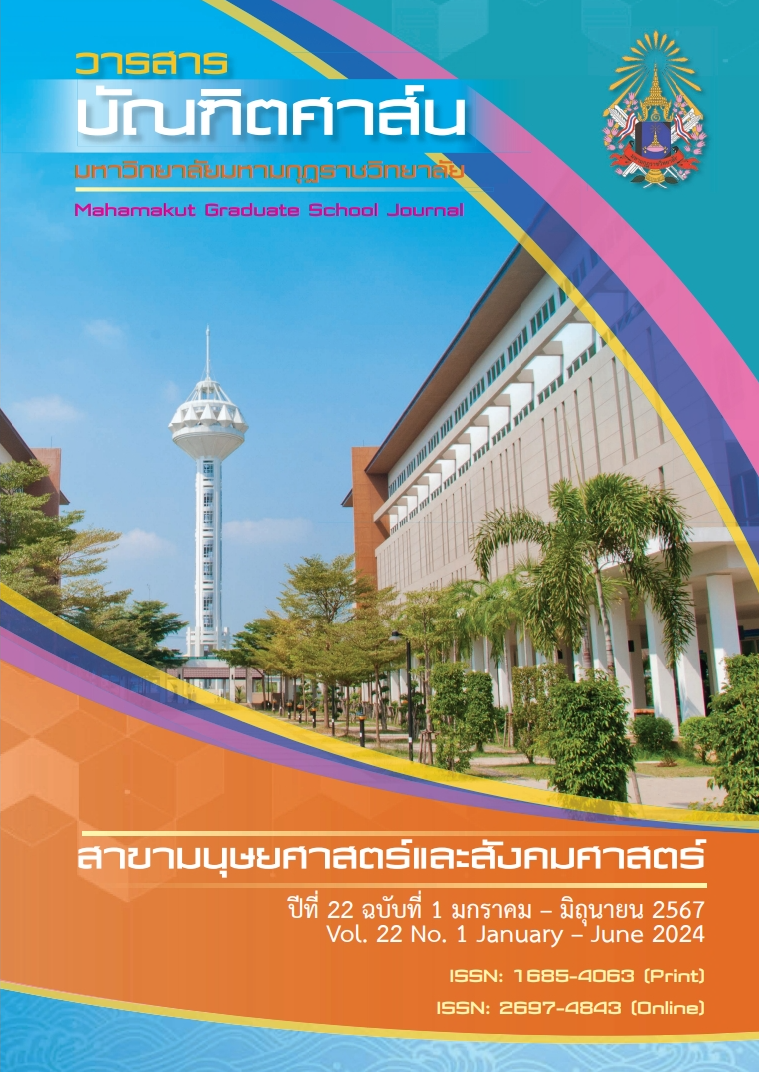The Effects of Job Characteristics and Total Rewards on Employee Innovation Performance in Shanxi Province, China
คำสำคัญ:
Job Characteristics, Total Rewards, Human Capital Investment, Employee Innovation Performanceบทคัดย่อ
Innovation is the soul of a nation's progress and the key to winning in the increasingly fierce competition. Innovation is the strategic support for the construction of a modern economic system and the first driving force for economic development. In order to establish and maintain the competitive advantages of enterprises and promote the sustainable development of China's economy, it is urgent for China's economy to shift from external power to internal power and from "factor driven" to "innovation driven".
This paper adopts a combination of qualitative and quantitative research methods. Through a sample survey of 1151 employees of enterprises in Shanxi Province, and in-depth interviews with 20 executives of human resources, R&D departments, front-line innovative employees, and researchers of human resources management theories, data analysis is conducted using NVIVO, SPSS and AMOS software. To verify the correctness of the model and hypothesis. It is found that Job Characteristics, Total Rewards and Human Capital Investment have significant positive effects on Employee Innovation Performance. Job Characteristics and Total Rewards have a significant positive impact on Human Capital Investment. Human Capital Investment plays an intermediary role among Job Characteristics, Total Rewards and Employee Innovation Performance.
เอกสารอ้างอิง
Armen Alchian(1950). Uncertainty, Evolution, and Economic Theory. Journal of Political Economy, (58-3),211-221
Bai Guiyu, Luo Rundong(2021). Research on the relationship between welfare incentives and Innovation Performance of Knowledge Workers. Jinan: Shandong Social Sciences, No.5.
Bank W.(2013). China 2030: Building a Modern, Harmonious, and Creative Society. World Bank Publications.
BECKER BE, HUSELID M A, PICKUS P S(1997). HR as a source of shareholder value: Research and recommendations. Human Resource Management, 36 (1) :39-47.
Chen Yunyun, Fang Fang, Zhang Yichi(2022). The relationship between high performance HRM and Employee performance: The role of Human Capital Investment intention. Economic Science, (5), 117-128.
Cheng Dejun, Zhao Shuming(2016). High participation work system and firm performance: The impact of human capital specificity and environmental dynamics. Management World ,(3), 86-93.
DAVENPORT TH, THOMAS R J, CANTRELL S(2002).The Mysterious Art and Science of Knowledge-Worker Performance. Mit Sloan Management Review,(44 -1), :23-30.
Deng Xuefen, Huang Gongxun, Zhang Xuying, et al(2012). An empirical study on the relationship between human capital and firm performance: A case study of high-tech enterprises. Macroeconomic Research ,(1), 73-79.
Drucker Peter.(1898). Innovation and Entrepreneurship. Beijing: Enterprise Management Press.
Gary Stanley Becker.(2016). Human Capital (3rd Ed.). Beijing: China Machine Press.
GLAESER E L(2010). On the Mechanics of Economic Development. Journal of Monetary Economics, (22-1), 3-42.
HACKMAN J R, OLDHAM G R(1976). Motivation through the design of work: test of a theory. Organizational Behavior & Human Performance ,(16-2), 250-279.
Han Yi.(2020). Construction and Empirical Research of Employee Job Performance Structure Model ( Doctoral Dissertation). Huazhong University of Science and Technology.
Hong Jian, Lin Fang(2017). Empirical Analysis of total compensation factors. Jiangsu Business Theory,(8), 125-127.
JANSSEN O, YPEREN N W(2004). Employees' Goal Orientations, the Quality of Leader-Member Exchange, and the Outcomes of Job Performance and Job Satisfaction. Academy of Management Journal ,(47-3), 368-384.
Le Wenrui,A. Y.&John.(2019).The Challenge of Innovation in China: Overcoming the Middle-income Trap, Beijing: Peking University Press.
Luo Pinliang, Si Chunlin(2021). Research on Specific Human Capital Investment Incentives. Tianjin: Journal of Management Science, (4).
OLDHAM G R, CUMMINGS A(1996). Employee Creativity: Oldham G R, Cummings A. Employee creativity: Personal And Contextual Factors at Work. Academy of Management Journal,(39-3), 607-634.
OLDHAM G R, KULIK T, AMBROSE M L(1986). Relations between job facet comparisons and employee reactions. Organizational Behavior & Human Decision Processes,(38-1),28-47.
Rovinelli, R. J. & Hambleton, R. K. (1977). On the Use of Content Specialists in the Assessment of Criterion-Referenced Test Item Validity. Dutch Journal of Educational Research, (2), 49-60.
SCOTT S G, BRUCE R A.(1994). Creating innovative behavior among R&D professionals: the moderating effect of leadership on the relationship between problem-solving style and innovation. Management Conference. Management in Transition: Engineering a Changing World, Proceedings of the 1994 IEEE International, 48-55.
Sun Wenjie, Shen Kunrong(2019). The difference between human capital accumulation and technological innovation efficiency in China's manufacturing industry. China Industrial Economics, (3) ,81-91.
Wang Fuxiang(2016). Analysis on the influence of Job Characteristics on Organizational Citizenship Behavior. Science and Management, (26-6) ,92-93.
Wang Hongfang, Yang Junqing(2019).The impact of Employee Total Rewards and Requirements -- Ability Matching on Job satisfaction: A Case study of Non-State-owned Enterprise, Taiyuan: Economic Issues, (No.5), 2019.
Wang Jianhua, Li Weiping, Zhang Kebiao(2015). "Does Executive Compensation in innovation-oriented Enterprises have Excessive incentives for Innovation Performance, Hefei: East China Economic Management, (1).
Wang Zhaohui, She Guoqiang.(2016) "High Performance work system and exploratory Innovation Performance: The multiple mediating roles of strategic human capital and innovation Climate", Nanjing: Science and Technology and Economy, (2).
Yang Julan, Yang Junqing(2022). The structure of employees' overall pay perception and its impact on organizational identity: an interpretation from the two-factor theory. Economic Management, (37-11), 63-73.
Yao Yao, Zhao Yingjun(2021). Endogenous Driving Force and micro-mechanism of global value chain evolution and upgrading: "Structure effect" and "intermediary effect" of human capital allocation. Zhejiang Social Sciences, (11),30-40.
Youndt M A, Snell S A(2004). Human Resource Configurations, Intellectual Capital, and Organizational Performance . Journal of Managerial Issues, (16 -3),337-360.
Yu Haiyun, Zhao Zengyao, Li Xiaozhong(2019).Effects and mechanisms of Innovation motivation on Innovation Performance of Private Enterprises: a moderating mediation model based on self-determination Theory. Forecast, (2),7-13.
ดาวน์โหลด
เผยแพร่แล้ว
รูปแบบการอ้างอิง
ฉบับ
ประเภทบทความ
สัญญาอนุญาต
ลิขสิทธิ์ (c) 2024 มหาวิทยาลัยมหามกุฏราชวิทยาลัย

อนุญาตภายใต้เงื่อนไข Creative Commons Attribution-NonCommercial-NoDerivatives 4.0 International License.
บทความวิชาการและบทความวิจัยในวารสารฉบับนี้ถือเป็นความรับผิดชอบของผู้เขียนเท่านั้น บทความที่ได้รับการตีพิมพ์ในวารสารบัณฑิตศาส์น ถือเป็นลิขสิทธิ์ของมหาวิทยาลัยมหามกุฏราชวิทยาลัย ตามพระราชบัญญัติลิขสิทธิ์



